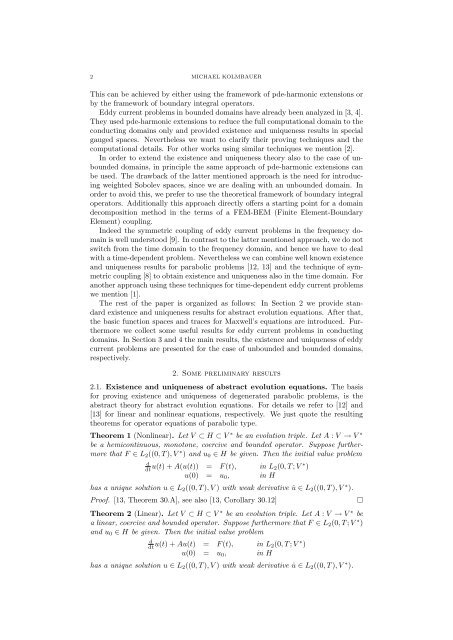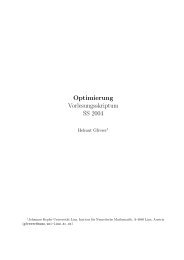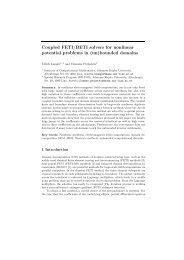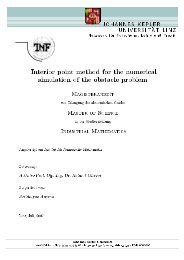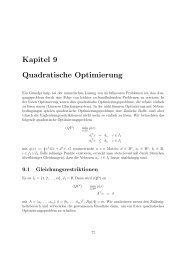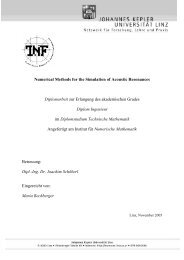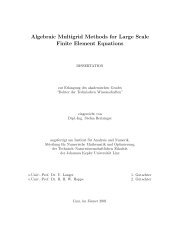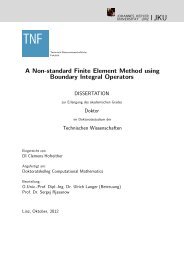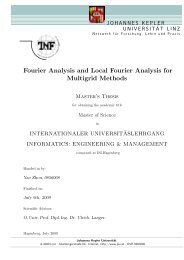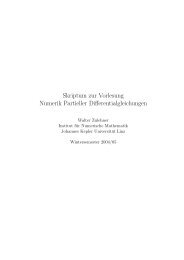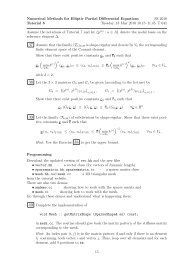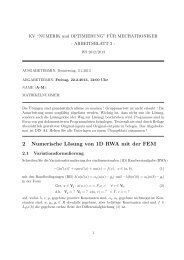Existence and Uniqueness of Eddy Current Problems in Bounded ...
Existence and Uniqueness of Eddy Current Problems in Bounded ...
Existence and Uniqueness of Eddy Current Problems in Bounded ...
Create successful ePaper yourself
Turn your PDF publications into a flip-book with our unique Google optimized e-Paper software.
2 MICHAEL KOLMBAUER<br />
This can be achieved by either us<strong>in</strong>g the framework <strong>of</strong> pde-harmonic extensions or<br />
by the framework <strong>of</strong> boundary <strong>in</strong>tegral operators.<br />
<strong>Eddy</strong> current problems <strong>in</strong> bounded doma<strong>in</strong>s have already been analyzed <strong>in</strong> [3, 4].<br />
They used pde-harmonic extensions to reduce the full computational doma<strong>in</strong> to the<br />
conduct<strong>in</strong>g doma<strong>in</strong>s only <strong>and</strong> provided existence <strong>and</strong> uniqueness results <strong>in</strong> special<br />
gauged spaces. Nevertheless we want to clarify their prov<strong>in</strong>g techniques <strong>and</strong> the<br />
computational details. For other works us<strong>in</strong>g similar techniques we mention [2].<br />
In order to extend the existence <strong>and</strong> uniqueness theory also to the case <strong>of</strong> unbounded<br />
doma<strong>in</strong>s, <strong>in</strong> pr<strong>in</strong>ciple the same approach <strong>of</strong> pde-harmonic extensions can<br />
be used. The drawback <strong>of</strong> the latter mentioned approach is the need for <strong>in</strong>troduc<strong>in</strong>g<br />
weighted Sobolev spaces, s<strong>in</strong>ce we are deal<strong>in</strong>g with an unbounded doma<strong>in</strong>. In<br />
order to avoid this, we prefer to use the theoretical framework <strong>of</strong> boundary <strong>in</strong>tegral<br />
operators. Additionally this approach directly <strong>of</strong>fers a start<strong>in</strong>g po<strong>in</strong>t for a doma<strong>in</strong><br />
decomposition method <strong>in</strong> the terms <strong>of</strong> a FEM-BEM (F<strong>in</strong>ite Element-Boundary<br />
Element) coupl<strong>in</strong>g.<br />
Indeed the symmetric coupl<strong>in</strong>g <strong>of</strong> eddy current problems <strong>in</strong> the frequency doma<strong>in</strong><br />
is well understood [9]. In contrast to the latter mentioned approach, we do not<br />
switch from the time doma<strong>in</strong> to the frequency doma<strong>in</strong>, <strong>and</strong> hence we have to deal<br />
with a time-dependent problem. Nevertheless we can comb<strong>in</strong>e well known existence<br />
<strong>and</strong> uniqueness results for parabolic problems [12, 13] <strong>and</strong> the technique <strong>of</strong> symmetric<br />
coupl<strong>in</strong>g [8] to obta<strong>in</strong> existence <strong>and</strong> uniqueness also <strong>in</strong> the time doma<strong>in</strong>. For<br />
another approach us<strong>in</strong>g these techniques for time-dependent eddy current problems<br />
we mention [1].<br />
The rest <strong>of</strong> the paper is organized as follows: In Section 2 we provide st<strong>and</strong>ard<br />
existence <strong>and</strong> uniqueness results for abstract evolution equations. After that,<br />
the basic function spaces <strong>and</strong> traces for Maxwell’s equations are <strong>in</strong>troduced. Furthermore<br />
we collect some useful results for eddy current problems <strong>in</strong> conduct<strong>in</strong>g<br />
doma<strong>in</strong>s. In Section 3 <strong>and</strong> 4 the ma<strong>in</strong> results, the existence <strong>and</strong> uniqueness <strong>of</strong> eddy<br />
current problems are presented for the case <strong>of</strong> unbounded <strong>and</strong> bounded doma<strong>in</strong>s,<br />
respectively.<br />
2. Some prelim<strong>in</strong>ary results<br />
2.1. <strong>Existence</strong> <strong>and</strong> uniqueness <strong>of</strong> abstract evolution equations. The basis<br />
for prov<strong>in</strong>g existence <strong>and</strong> uniqueness <strong>of</strong> degenerated parabolic problems, is the<br />
abstract theory for abstract evolution equations. For details we refer to [12] <strong>and</strong><br />
[13] for l<strong>in</strong>ear <strong>and</strong> nonl<strong>in</strong>ear equations, respectively. We just quote the result<strong>in</strong>g<br />
theorems for operator equations <strong>of</strong> parabolic type.<br />
Theorem 1 (Nonl<strong>in</strong>ear). Let V ⊂ H ⊂ V ∗ be an evolution triple. Let A : V → V ∗<br />
be a hemicont<strong>in</strong>uous, monotone, coercive <strong>and</strong> bounded operator. Suppose furthermore<br />
that F ∈ L 2 ((0, T ), V ∗ ) <strong>and</strong> u 0 ∈ H be given. Then the <strong>in</strong>itial value problem<br />
d<br />
dt u(t) + A(u(t)) = F (t), <strong>in</strong> L 2(0, T ; V ∗ )<br />
u(0) = u 0 , <strong>in</strong> H<br />
has a unique solution u ∈ L 2 ((0, T ), V ) with weak derivative ˙u ∈ L 2 ((0, T ), V ∗ ).<br />
Pro<strong>of</strong>. [13, Theorem 30.A], see also [13, Corollary 30.12]<br />
Theorem 2 (L<strong>in</strong>ear). Let V ⊂ H ⊂ V ∗ be an evolution triple. Let A : V → V ∗ be<br />
a l<strong>in</strong>ear, coercive <strong>and</strong> bounded operator. Suppose furthermore that F ∈ L 2 (0, T ; V ∗ )<br />
<strong>and</strong> u 0 ∈ H be given. Then the <strong>in</strong>itial value problem<br />
d<br />
dt u(t) + Au(t) = F (t), <strong>in</strong> L 2(0, T ; V ∗ )<br />
u(0) = u 0 , <strong>in</strong> H<br />
has a unique solution u ∈ L 2 ((0, T ), V ) with weak derivative ˙u ∈ L 2 ((0, T ), V ∗ ).<br />
□


